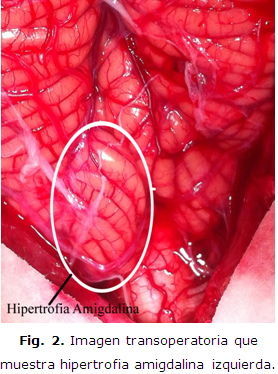Asymmetric amygdaloid ectopia in type-I Chiari malformation: a case report
Keywords:
, Arnold-Chiari malformation, Hypertrophy.Abstract
Introduction: type I Chiari malformation was described in 1891 by Hanz Chiari. It is characterized by an ectopia or descent of the cerebellar tonsils through the foramen magnum. This malformation more often occurs in adolescence or adulthood. Patients may be asymptomatic or present neurological symptoms that include: headache, neck pain, ataxia, dizziness, hemiparesis or long-ways syndrome, among others, depending on the degree of descent and associated pathologies. Pure unilateral ectopy is rarely found, thus why this clinical case is reported.
Case report: a 46 year-old patient, with a history of sub-occipital headache of 2-year evolution, progressive loss of muscle strength of the right hemisphere with attitude trembling, more marked on the right arm and gait difficulty. A cranial magnetic resonance [MR] was indicated, visualizing a descent of 9mm in the left cerebellar tonsil. Decompressive craniectomy of the posterior fossa was performed, more lateralized to the left, osteotomy of the posterior arch of the atlas along with the internal dural expanding; showing satisfactory progress.
Conclusions: asymmetrical Chiari type-I malformation is frequent, but not much medical literature on the subject is found, asymmetry may trigger unilateral symptoms. The unilateral amygdaloid hypertrophy is a rare entity, which may be associated with type-I Chiari malformation.Downloads
References
REFERENCIAS BIBLIOGRÁFICAS
1. Chiari H: Über Veränderungen des Kleinhirns infolge von Hydrocephalie des Grosshirns. Dtsch Med Wochenschr 1891;17:1172–1175. Original Paper.
2. Tubbs S R, Wellons JC, Oakes WJ. Asymmetry of Tonsillar Ectopia in Chiari I Malformation. Pediatric Neurosurg. 2002;37:199–202
3. Karppinen A, Koljonen V, Valanne L, Leikola J. Asymmetric laterality of Chiari type I malformation in patients with non-syndromic single-suture craniosynostosis. Acta Neurochir (Wien). 2012 Nov;154(11):2103-7. Original Paper. Disponible en: http://link.springer.com/article/10.1007/s00701-012-1470-6/fulltext.html.
4. Meadows J, Kraut M, Guarnieri M, Haroun RI, Carson BS: Asymptomatic Chiari Type I malformations identified on magnetic resonance imaging. J Neurosurg 2000; 92(6):920–926. Disponible en: http://thejns.org/doi/abs/10.3171/jns.2000.92.6.0920.
5. Silky Chotai, Azedine Medhkour. (2014) Surgical outcomes after posterior fossa decompression with and without duraplasty in Chiari malformation-I. Clinical Neurology and Neurosurgery 2014; 125; 182-188. . Online publication date: 1-Oct-2014. Disponible en: https://www.clinicalkey.es/#!/content/playContent/1-s2.0-S030384671400287X?returnurl=http:%2F%2Flinkinghub.elsevier.com%2Fretrieve%2Fpii%2FS030384671400287X%3Fshowall%3Dtrue&referrer=http:%2F%2Fwww.sciencedirect.com%2Fscience%2Farticle%2Fpii%2FS030384671400287X.
6. Förander P , Sjåvik K, Solheim O, Riphagen I, Gulati S et al. The case for duraplasty in adults undergoing posterior fossa decompression for Chiari I malformation: A systematic review and meta-analysis of observational studies. Clinical Neurology and Neurosurgery 2014; 125: 58-64. Disponible en: https://www.clinicalkey.es/#!/content/playContent/1-s2.0-S0303846714002790?returnurl=http:%2F%2Flinkinghub.elsevier.com%2Fretrieve%2Fpii%2FS0303846714002790%3Fshowall%3Dtrue&referrer=http:%2F%2Fwww.sciencedirect.com%2Fscience%2Farticle%2Fpii%2FS0303846714002790.
7. Chotai S, Kshettry VR , Lamki, T Ammirati M. Surgical outcomes using wide suboccipital decompression for adult Chiari I malformation with and without syringomyelia. Clinical Neurology and Neurosurgery 2014;120: 129-135. . Online publication date: 1-May-2014. Disponible en: https://www.clinicalkey.es/#!/content/playContent/1-s2.0-S0303846714000663?returnurl=http:%2F%2Flinkinghub.elsevier.com%2Fretrieve%2Fpii%2FS0303846714000663%3Fshowall%3Dtrue&referrer=http:%2F%2Fwww.sciencedirect.com%2Fscience%2Farticle%2Fpii%2FS0303846714000663.
8. Jennifer Hong, David W. Roberts. (2014) The Surgical Treatment of Headache. Headache: The Journal of Head and Face Pain 2014; 54(3): , 409-429. Online publication date: 1-Mar-2014. Disponible en: http://onlinelibrary.wiley.com/doi/10.1111/head.12294/pdf.
9.Xiaofeng Deng, Chenlong Yang, Jiahe Gan, Liang Wu, Tao Yang, Jun Yang, Yulun Xu. (2015) Long-Term Outcomes After Small-Bone-Window Posterior Fossa Decompression and Duraplasty in Adults with Chiari Malformation Type I. World Neurosurgery, 2015-10-01, Volúmen 84, Número 4, Pages 998-1004. Online publication date: 1-Oct-2015. Disponible en: https://www.clinicalkey.es/#!/content/playContent/1-s2.0-S1878875015000832?returnurl=http:%2F%2Flinkinghub.elsevier.com%2Fretrieve%2Fpii%2FS1878875015000832%3Fshowall%3Dtrue&referrer=http:%2F%2Fwww.sciencedirect.com%2Fscience%2Farticle%2Fpii%2FS1878875015000832.
10. Klekamp J. Chiari I malformation with and without basilar invagination: a comparative study. Neurosurgical Focus 2015 38(4): E12. Online publication date: 1-Apr-2015. Disponible en: http://thejns.org/doi/full/10.3171/2015.1.FOCUS14783.
11. Greenberg JK, Yarbrough, CY, Radmanesh A, Godzik J,Yu M.The Chiari Severity Index.A Preoperative Grading System for Chiari Malformation Type 1. Neurosurgery 2015; 76(3): 279-285. . Online publication date: 1-Mar-2015. Disponible en: http://journals.lww.com/neurosurgery/Fulltext/2015/03000/The_Chiari_Severity_Index___A_Preoperative_Grading.6.aspx.
12. Greenberg JK, Milner E, Yarbrough CK, Lipsey K, Piccirillo JF. Outcome methods used in clinical studies of Chiari malformation Type I: a systematic review. Journal of Neurosurgery 2015 122(2): 262-272.
13. Arnautovic A1, Splavski B, Boop FA, Arnautovic KI. Pediatric and adult Chiari malformation Type I surgical series 1965–2013: a review of demographics, operative treatment, and outcomes. Journal of Neurosurgery 2015:15:(2): 161-177. Disponible en: http://www.ncbi.nlm.nih.gov/pubmed/25479580.

Published
How to Cite
Issue
Section
License
Authors who have publications with this journal agree to the following terms: Authors will retain their copyrights and grant the journal the right of first publication of their work, which will be publication of their work, which will be simultaneously subject to the Creative Commons Attribution License (CC-BY-NC 4.0) that allows third parties to share the work as long as its author and first publication in this journal are indicated.
Authors may adopt other non-exclusive license agreements for distribution of the published version of the work (e.g.: deposit it in an institutional telematic archive or publish it in a volume). Likewise, and according to the recommendations of the Medical Sciences Editorial (ECIMED), authors must declare in each article their contribution according to the CRediT taxonomy (contributor roles). This taxonomy includes 14 roles, which can be used to represent the tasks typically performed by contributors in scientific academic production. It should be consulted in monograph) whenever initial publication in this journal is indicated. Authors are allowed and encouraged to disseminate their work through the Internet (e.g., in institutional telematic archives or on their web page) before and during the submission process, which may produce interesting exchanges and increase citations of the published work. (See The effect of open access). https://casrai.org/credit/


